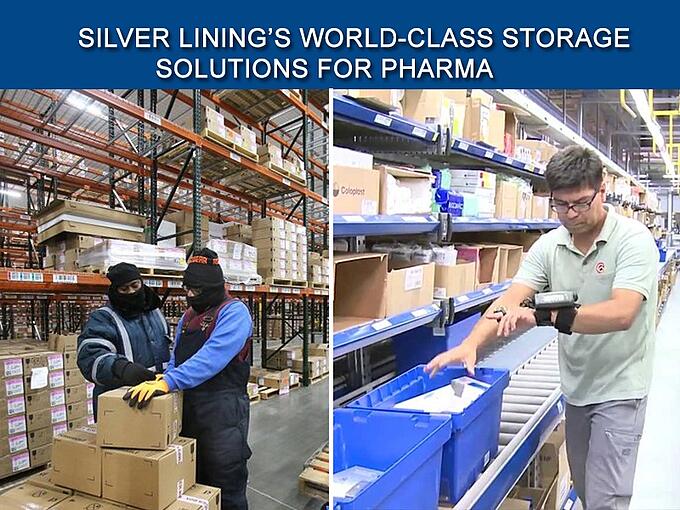The key challenges faced by the pharmaceutical industry are
- Globalisation
- Tighter regulations & inspections
- Cost pressures
- Complex supply chains
As a response to these challenges, pharmaceutical companies not only have to constantly innovate and develop newer, better products, but also find ways to formulate sophisticated supply chain processes and strategies for better adherence to quality and reliability. Efficient and optimised pharma logistics and distribution becomes a critical differentiator in a complex world of regulation, compliance and global supply chains. Inventory management, especially efficient end-to-end supply chain planning and visibility, assumes vital importance in this industry. Clearer visibility of inventory will be useful as potential excess supply of a product in one place can be moved in time to prevent supply shortages in other places.
Pharmaceutical Warehouse Requirements:
Pharmaceutical products need to be stored under strict conditions; requirements such as hygiene, temperature, traceability are paramount in this sector. Specifically, the following challenges have to be taken into consideration when designing warehouses of pharmaceutical industry:
- Ideal temperature to maintain efficacy of drugs: Different drugs have different temperatures at which they become deactivated/denatured. Hence, they should be stored in appropriately maintained temperature and humidity zones. Warehousing solutions provide different temperature zones (Ambient (15–25ºC), Cold Room (2–8ºC), Freezers (minus 25–minus 15ºC) and Ultra-low Temperature Freezer Rooms (<minus 25ºC)) that can be individually controlled and maintained with the help of sensors and alarms.
- Total traceability for fail-safe monitoring of expiry dates: Minimal hand-touch and mechanised tracking of inventory is essential to keep track of usable, expired, recalled or returned stock as well as stock for temporary as well as bulk storage. The pharmaceutical warehouse design needs to account for a designated area for such stock segregation.
- Clean and protected environment: Storage facilities for pharmaceutical warehouses need to be free from accumulated waste or vermin. They also need to be able to allow pest-control programs that do not contaminate the chemicals or drugs.
- Sterile environment: Certain products require a total absence of microbial contamination, with minimal human intervention.
- Space for a wide range varied SKUs: Depending upon seasonality, different drugs might be stored in warehouses at different times of the year. The pharmaceutical warehouse layout design should be such that space should be adequate and the configuration should be flexible enough to accommodate such changes.
- High Safety Standards: Pharmaceutical warehouses need to ensure that their storage facilities are compliant with USFDA and OHSAS standards.
- Technology: From RFID (Radio Frequency Identification) labeling and contamination protection devices to full-fledged pharmaceutical Warehouse Management Systems, technology and intelligent tools can significantly raise the efficiency, output and profitability.
For fulfilling the above purposes, some storage systems are preferred over others in pharmaceutical warehouses. Depending upon the goods packed and the products stored, the warehouse infrastructure and racking/shelving systems are designed and installed.
The most common types of racking/shelving systems used in pharmaceutical warehouses are:
- Selective Pallet Racking (SPR): The most versatile of racking systems, this adjustable racking system makes full use of the entire height of the warehouse for storage that can be 100% selective. With complete utilization of available vertical space, SPR provides a best-value solution for medical warehouses as the SKUs can be stored and retrieved according to expiry dates, temperature conditions etc. Selectively retrieving and restocking specific cartons of SKUs becomes simple with this kind of storage racks. Understandably, they’re one of the most popular and ‘in-demand’ storage systems for warehouses in pharmaceutical industry.
- VNA Pallet Racking: Very Narrow Aisle (VNA) Pallet Racking makes do with very less space for aisles; this space can instead be used for more racks, thus maximizing the available floor space for storage. This system required specialized material handling equipment that can maneuver in the narrow aisles where regular forklifts cannot.
- AS/RS (Automated Storage/Retrieval System): One of the main concerns in pharmaceutical storage is that products should move out of warehouse well before their expiry time. Stock visibility and turnover is critical for time-sensitive products such as medicines. AS/RS gives greater visibility and zero error picking, thus increasing the speed by which products can be stored or retrieved from racking system, and moved in and out of the pharmaceutical warehouse. The automated storing and picking function increases accuracy and productivity, adding to the bottom line of the company.
SILVER LINING Storage Solutions provides intelligent and safe storage solutions for pharmaceuticals, drugs and chemicals. Our storage systems comply with Good Manufacturing Practices (GMP) for safekeeping and handling of inventory in these sectors.
Mentioned below are some of our value propositions in developing storage facilities for the pharmaceutical industry.
- Controlled and protected environment
- Custom storage solutions based on inventory sensitivity
- Stock visibility and need-based renewal of stock
If you would like to have an efficient and EN-conformed storage system in your warehouse or manufacturing facility or re-engineer the existing facility, write to us. We will get in touch with you.
You may visit our products page for more information about the entire range of products, solutions and their features.
Thank you for reading our post. If you would like to read our regular posts, please ‘Follow us on Linkedin.
Topics: Pharma Warehouse Storage Solutions, Warehouse Optimization, Warehouse Operations

